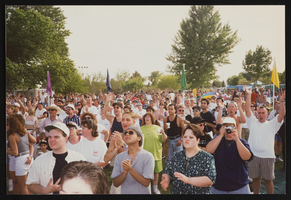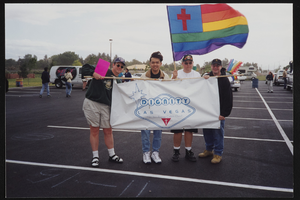Search the Special Collections and Archives Portal
Search Results

Crowd watching Cyndi Lauper perform at Gay Pride, image 012: photographic print
Date
Archival Collection
Description
Gay Pride 1997 (Dennis McBride, photographer), Sunset Park, 5-10-97. Cyndi Lauper entertaining.
Image
Las Vegas Bugle Photograph Collection on Lesbian, Gay, Bisexual, and Transgender History
Identifier
Abstract
The
Archival Collection

Dr. Linda K. Miller oral history interview: transcript
Date
Archival Collection
Description
Oral history interview with Dr. Linda K. Miller conducted by Claytee D. White on July 10, 2019 for Boyer Early Las Vegas Oral History Project. In this interview, Dr. Miller discusses her early life in Kansas City, Kansas and arriving to Las Vegas, Nevada in 2002. She talks about Helen J. Stewart, the Old Mormon Fort, and the significance of that area. Later, Dr. Miller explains the importance of teaching local history to people in Las Vegas. Lastly, Dr. Miller discusses the process of writing a book about Helen J. Stewart.
Text

Julian Eusebio oral history interview: transcript
Date
Archival Collection
Description
Oral history interview with Julian Eusebio conducted by Cecilia Winchell, Jerwin Tiu, and Stefani Evans on June 01, 2022 for the Reflections: the Las Vegas Asian American and Pacific Islander Oral History Project. In this interview, Eusebio discusses his childhood in the Philippines countryside, helping his parents farm and harvest rice. After moving to Manila for college, Eusebio studied architecture and illustrated for comics and magazines. After moving to Los Angeles, California, Eusebio started a construction business, doing landscapes and constructing swimming pools for celebrities such as Michael Jackson. In 1992, he opened another branch in Las Vegas, Nevada. After retiring in 2010, Eusebio took up painting again and cites his favorite artists as Norman Rockwell and Rembrandt. In the remainder of the interview, he discusses his drawing process and how he started showing his artwork throughout the Las Vegas Clark County Library District.
Text
S. J. Johnson oral history interview
Identifier
Abstract
Oral history interview with S. J. Johnson conducted by Claytee D. White on May 24, 2016 for the African Americans in Las Vegas: a Collaborative Oral History Project. In this interview, Johnson discusses his early life in Indianapolis, Indiana and living on his family's farm. He recalls joining the United States Air Force, adjusting to life outside of the family farm, and experiencing discrimination while serving. Johnson talks about being stationed in Panama, joining the Air Force Office of Special Investigations (AFOSI), and becoming a military officer. Later, Johnson discusses his move to Las Vegas, Nevada in 1982, attending the University of Nevada, Las Vegas, and obtaining his teaching license. Lastly, Johnson talks about the importance of education.
Archival Collection
Lesbian and Gay Academic Union (LGAU)
Level of Description
Archival Collection
Collection Name: Las Vegas, Nevada LGBTQ Collection
Box/Folder: N/A
Archival Component
D. D. Cotton oral history interview
Identifier
Abstract
Oral history interview with D. D. (Ethel Dolores) Cotton conducted by Claytee White on February 14, 1997 and March 21, 1997 for the Women's Research Institute of Nevada (WRIN) Las Vegas Women Oral History Project. In this interview, Cotton discusses the beginnings of her dance career in New York City, New York. Later in the interview, Cotton discusses working in Las Vegas, Nevada at the Cotton Club and her interactions with other African American entertainers. Cotton also discusses race relations and her experiences as an African American dancer in Las Vegas. Cotton later goes on to discuss her career change in the service industry.
Archival Collection

Reverend Jay DiCotignano and unidentified persons at the second annual Gay Pride parade: photographic print
Date
Archival Collection
Description
Image
J. D. Smith oral history interview
Identifier
Abstract
Oral history interview with J. D. Smith conducted by Albert Hewitt on October 31, 1979 for the Ralph Roske Oral History Project on Early Las Vegas. Smith begins by discussing his move to Las Vegas, Nevada in 1927 after buying an office for his dental practice. He describes life in Las Vegas at the time, how the city has expanded and changed, and his career as a dentist. Smith also talks about his time as president of the Nevada State Board of Education. He concludes by elaborating on other aspects of Las Vegas history, such as the crash of Carole Lombard's plane, the Helldorado Parades, and nuclear weapons testing.
Archival Collection
Juan Saa oral history interview
Identifier
Abstract
Oral history interview with Juan Saa conducted by David G. Schwartz on November 21, 2016 for the Slot Operations Oral History Project. Saa discusses his start in the technical side and his eventual move into an operational role in the casino industry. He talks about his experience as a director, specifically the responsibilities involved, and the type of staff being supervised. Saa then describes what he believes are the biggest changes in the slot industry, specifically with ticket-in, ticket-out (TITO); and slot analysis.
Archival Collection
